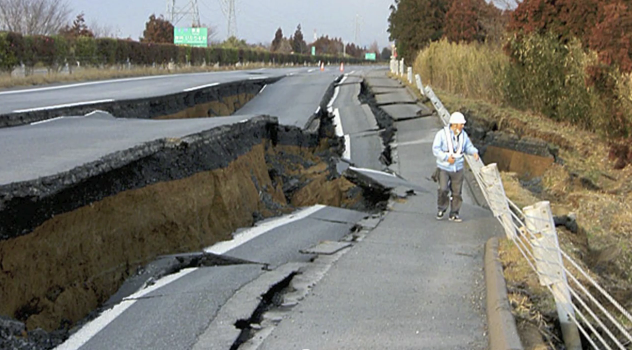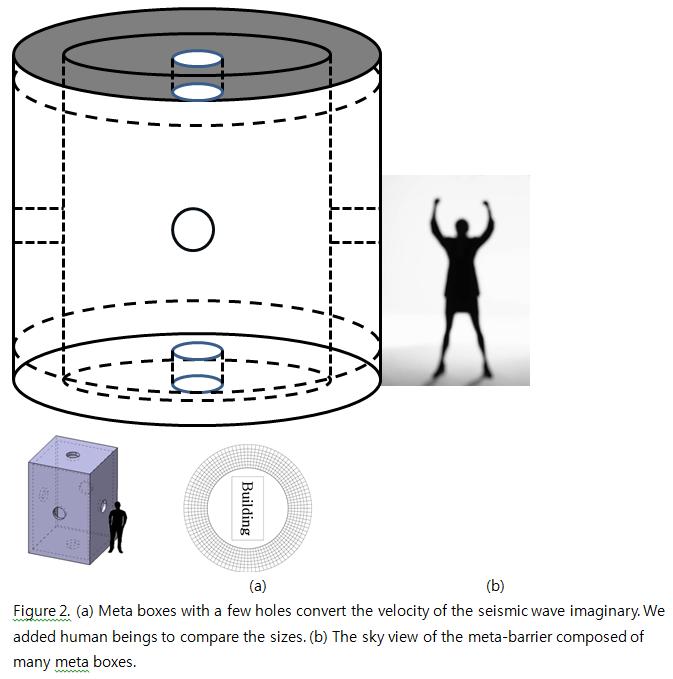
Sang-Hoon Kim - shkim@mmu.ac.kr
Division of Marine Engineering
Mokpo National Maritime University
Mokpo 530-729, R. O. Korea
Popular version of paper 2aEA8
Presented Tuesday morning, May 15, 2012
163rd ASA Meeting, Hong Kong
The sudden oncoming of seismic waves with large amplitudes and low frequencies has been a serious threat to life and property. It is the collapse of bridges, dams, power plants, and other structures that cause extensive damage and loss of life during earthquakes. Aseismic capabilities are highly relevant to public safety, and numerous earthquake-proof engineering methods have been tried to resist earthquakes, but safety is still far away.

Figure 1. March, 2011, Japan (youtube)
Seismic waves are a kind of inhomogeneous acoustic wave with various wavelengths and there are two types of seismic waves: body waves and surface waves. P (Primary) and S (Secondary) waves are the body waves, and R (Rayleigh) and L (Love) waves are the surface waves. Surface waves decay slower than body waves and are most destructive because of their low frequency, long duration, and large amplitude.
We introduce a method to control seismic waves by using a new class of materials called metamaterials. Metamaterials are artificially engineered materials that have a special property such as negative refractive index. We present a solution that a metamaterial acts as an attenuator by converting the destructive seismic wave into an attenuated wave..
Seismic medium of Earth crust can be considered as an accumulation of infinite number of elastic plates. The velocity of the seismic surface wave is mainly dependent upon the density, ρ, and shear modulus, G, of the seismic medium.:
![]() . If the shear modulus becomes negative, then the velocity becomes imaginary. Therefore, the imaginary velocity makes the amplitude of the seismic wave become an attenuated one.
. If the shear modulus becomes negative, then the velocity becomes imaginary. Therefore, the imaginary velocity makes the amplitude of the seismic wave become an attenuated one.
Negative shear modulus of elastic media has been studied and realized recently. The key is the Helmholtz resonator. The resonance of accumulated waves in the Helmholtz resonator reacts against the applied pressure at some specific frequency ranges. Then, the negative modulus is realized by passing the acoustic wave through an array of Helmholtz resonators. It makes the sound intensity decay at some resonant frequency ranges.
We build an attenuator or an earthquake-proof barrier of a seismic wave by filling-up many resonators under the ground around the building that we want to protect. The amplitude of the seismic wave that passed the waveguide is reduced at the frequency ranges of negative modulus. Mixing up many different kinds of resonators will cover many different corresponding frequency ranges of the seismic waves.
In civil engineering earthquake-proofing methods should be practical, that is, clear to manufacture and easy to construct. The size of the cylinder can be estimated from the analogy between electric circuits and mechanical pipes. An example of the design of the meta-cylinder for the seismic frequency range is plotted in the Figure 2(a). The shape of the meta-cylinder is neither necessary to be circular nor to have 6 holes. Cubic or hexagonal boxes would be fine, too. As increasing the number of holes, it is appropriate for higher resonant frequencies.

The building is surrounded by shell-type metamaterials in Figure 2(b), but it is not necessary to be circular. The aseismic ability depends on the thickness of the barrier. The depth of the waveguide in Figure 2(b) should be at least the foundation work of the building to protect, but it is not necessary to be more than the wavelength of the surface waves. Controlling the width and refractive index of the waveguide, we can upgrade the aseismic range of the building as needed.
There happens an energy dissipation of the seismic waves inside of the waveguide and the absorbed energy will turn into sound and heat. Electrical and mechanical resonance circuits dissipate energy both. In the former one, such as a microwave oven, the electromagnetic energy is converted to more heat than sound. On the other hand, in the latter one, the seismic energy is converted to more sound than heat.
This seismic attenuator will be effective for isolated buildings because we need some areas to construct the aseismic range. It may be applicable for social overhead capitals such as power plants, dams, airports, nuclear reactors, oil refining complexes, long-span bridges, express rail-roads, etc.
More helpful information of the research in this article would be found at the site: http://www.technologyreview.com/blog/arxiv/27566/
This research was supported by Basic Science Research Program through the National Research Foundation of Korea (NRF) funded by the Ministry of Education, Science and Technology (2011-0009119).